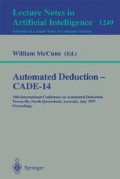Abstract
We present a new method, called non-Horn magic sets (NHM), to enhance forward reasoning provers by combining top-down and bottom-up computations. This method is a natural extension of Horn magic sets and is applicable to range-restricted non-Horn clauses. We show two types of transformations to get non-Horn magic sets from the given clause sets: breadth-first NHM and depth-first NHM. The first transformation evaluates the antecedent atoms of an original clause in parallel. The second one evaluates them sequentially while propagating the bindings in an antecedent atom to the next by using continuation predicates. These transformations are shown to be sound and complete. The NHM method has been implemented on a UNIX workstation. We evaluated effects of NHM by proving some typical problems taken from the TPTP problem library.
Access this chapter
Tax calculation will be finalised at checkout
Purchases are for personal use only
Preview
Unable to display preview. Download preview PDF.
References
Akahani, J., Inoue, K. and Hasegawa, R.: Bottom-up modal theorem proving based on modal clause transformation, Trans. Information Processing Society of Japan, Vol. 36, No. 4, pp. 822–831 (1995), in Japanese.
Arayama, M. and Inoue, K.: Optimizations of query processing for disjunctive deductive databases, Trans. Information Processing Society of Japan, Vol. 37, No. 12, pp. 2295–2304 (1996), in Japanese.
Bancilhon, F., Maier, D., Sagiv, Y. and Ullman, J.D.: Magic sets and other strange ways to implement logic programs, Proc. 5th ACM SIGMOD-SIGACT Symp. on Principles of Database Systems, pp. 1–15 (1986).
Beeri, C. and Ramakrishnan, R.: On the power of magic, Proc. Sixth ACM Symp. on Principles of Database Systems, pp. 269–283 (1987).
Bry, F.: Query evaluation in recursive databases: bottom-up and top-down reconciled, Data & Knowledge Engineering, Vol. 5, pp. 289–312 (1990).
Bry, F. and Yahya, A.: Minimal model generation with positive unit hyper-resolution tableaux, Proc. TABLEAUX'96, LNAI 1071, pp. 143–159 (1996).
Demolombe, R.: An efficient strategy for non-Horn deductive databases, Theoretical Computer Science, Vol. 78, pp. 245–259 (1991).
Loveland, D.W., Reed, D.W. and Wilson, D.S.: SATCHMORE: SATCHMO with RElevancy, J. Automated Reasoning, Vol. 14, No. 2, pp. 325–351 (1995).
Hasegawa, R. and Fujita, H.: A model generation theorem prover in KL1 using ramified-stack algorithm, Proc. 8th ICLP, pp. 535–548 (1991).
Hasegawa, R., Ohta, Y. and Inoue, K.: Non-Horn magic sets and their relation to relevancy testing, Technical Report ICOT-TR-834, ICOT, Tokyo, (1993).
Hasegawa, R.: Parallel theorem-proving system: MGTP, Proc. FGCS'94, pp. 51–65 (1994).
Hasegawa, R. and Koshimura, M.: An AND parallelization method for MGTP and its evaluation, Proc. Int. Symp. on PASCO'94, pp. 194–203 (1994).
Hasegawa, R. and Fujita, H.: MGTP: a model generation theorem prover in the concurrent logic programming language KL1, Trans. Information Processing Society of Japan, Vol. 37, No. 1, pp. 1–12 (1996), in Japanese.
Manthey, R. and Bry, F.: SATCHMO: a theorem prover implemented in Prolog, Proc. CADE-9, LNCS 310, pp. 415–434 (1988).
Nakashima, H., Nakajima, K., Kondoh S., Takeda Y., Inamura, Y., Onishi, S. and Masuda, K.: Architecture and implementation of PIM/m, Proc. FGCS'92, pp. 425–435 (1992).
Ohta, Y., Inoue, K. and Hasegawa, R.: The equivalence between non-Horn magic sets and relevancy testing, submitted for publication (1996), in Japanese.
Rohmer, J., Lescoeur, R. and Kerisit, J.M.: The Alexander method — a technique for the processing of recursive axioms in deductive databases, New Generation Computing, Vol. 4, pp. 273–285 (1986).
Stickel, M.E.: Upside-down meta-interpretation of the model elimination theorem-proving procedure for deduction and abduction, J. Automated Reasoning, Vol. 13, No. 2, pp. 189–210 (1994).
Suttner, C. and Sutcliffe, G.: The TPTP problem library, Technical report AR-94-03, Institut für Informatik, Technische Universität München, Munich, Germany (also available as Technical report 93/11, Department of Computer Science, James Cook University, Townsville, Australia) (1994).
Ueda, K. and Chikayama, T.: Design of the kernel language for the parallel inference machine, Computer J., Vol. 33, No. 6, pp. 494–500 (1990).
Yahya, A.H.: A goal-driven approach to efficient query processing in disjunctive databases, Research Report PMS-FB-1996-12, Institut für Informatik, Ludwig Maximilians Universität München (1996).
Author information
Authors and Affiliations
Editor information
Rights and permissions
Copyright information
© 1997 Springer-Verlag Berlin Heidelberg
About this paper
Cite this paper
Hasegawa, R., Inoue, K., Ohta, Y., Koshimura, M. (1997). Non-horn magic sets to incorporate top-down inference into bottom-up theorem proving. In: McCune, W. (eds) Automated Deduction—CADE-14. CADE 1997. Lecture Notes in Computer Science, vol 1249. Springer, Berlin, Heidelberg. https://doi.org/10.1007/3-540-63104-6_18
Download citation
DOI: https://doi.org/10.1007/3-540-63104-6_18
Published:
Publisher Name: Springer, Berlin, Heidelberg
Print ISBN: 978-3-540-63104-0
Online ISBN: 978-3-540-69140-2
eBook Packages: Springer Book Archive

